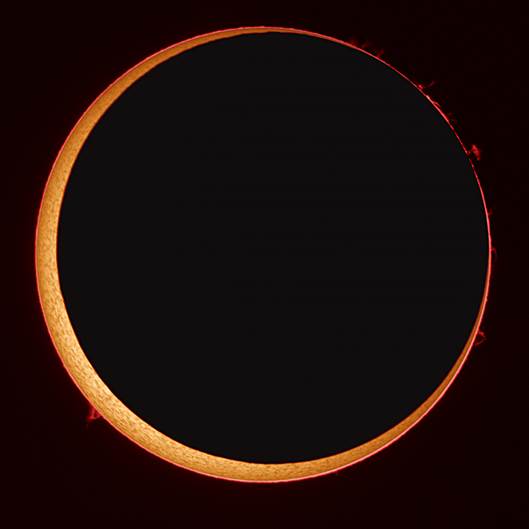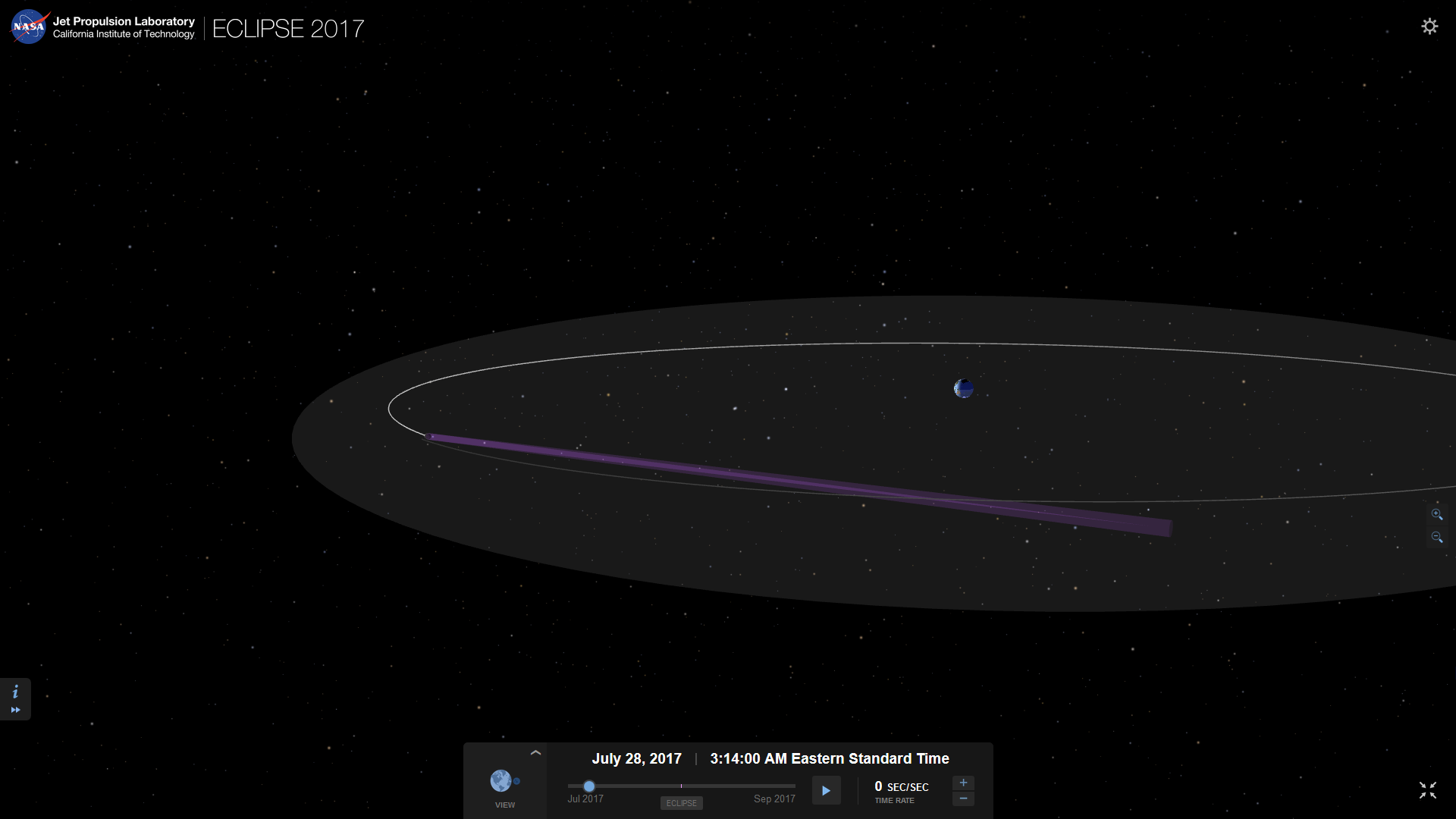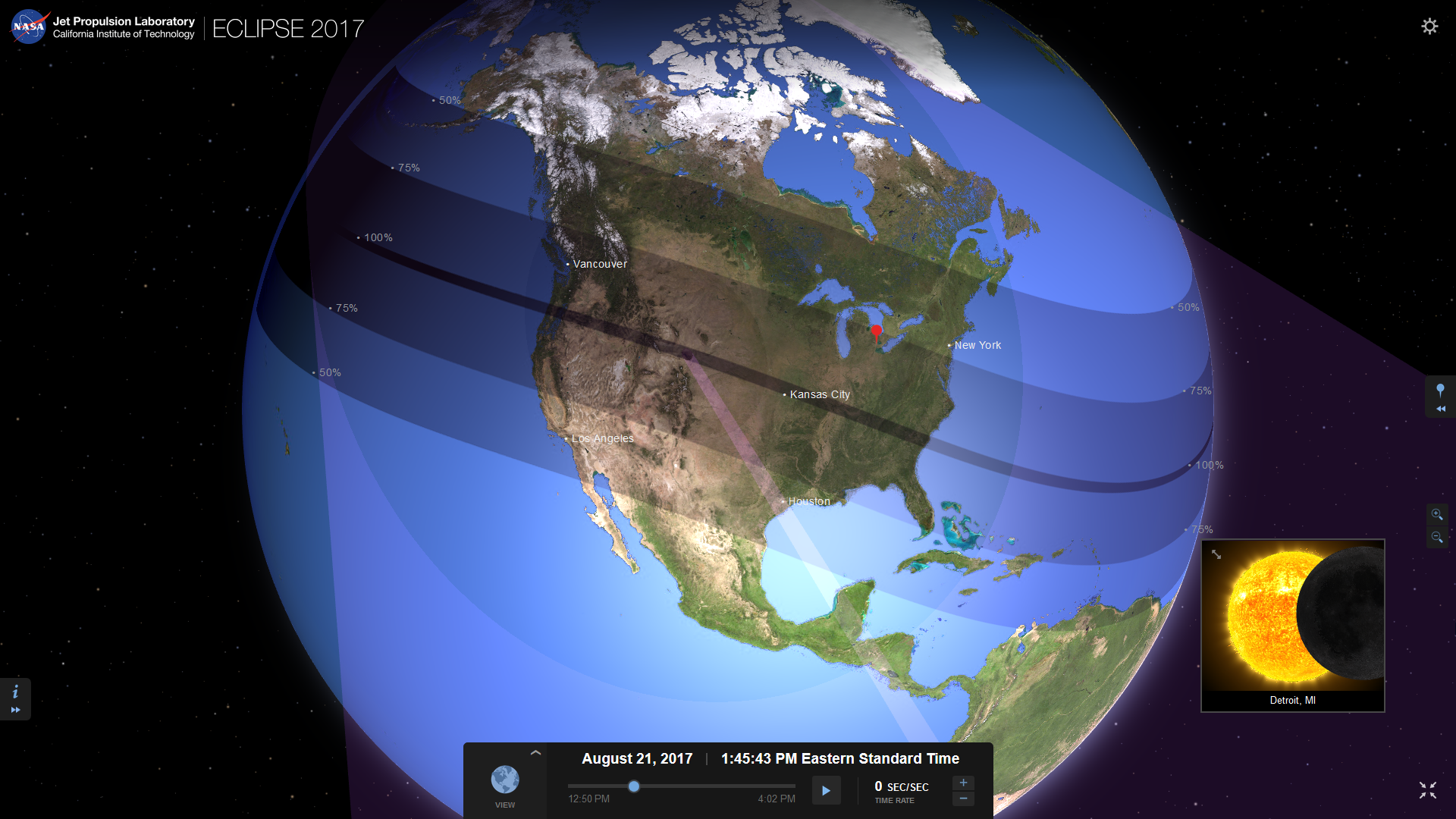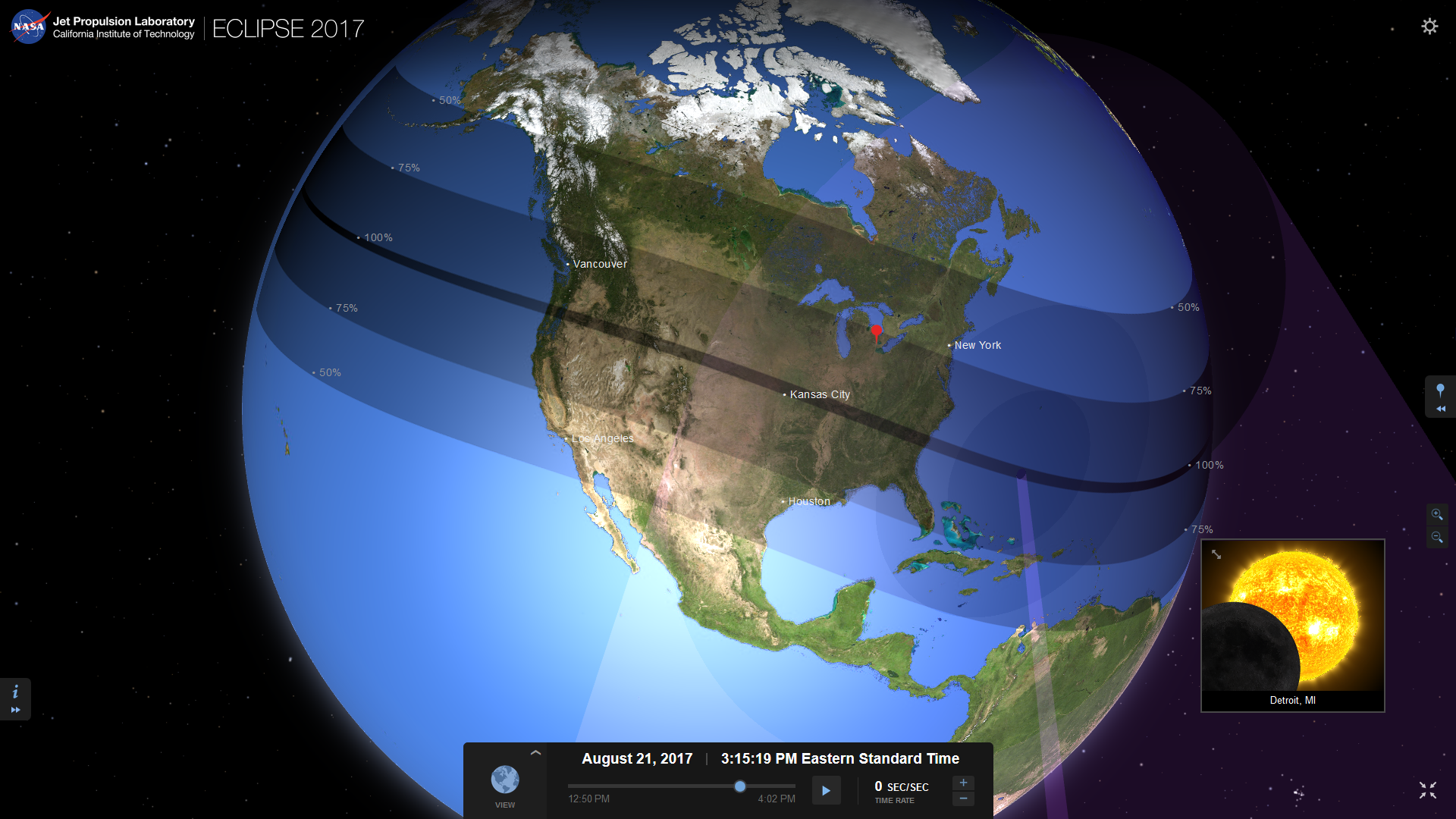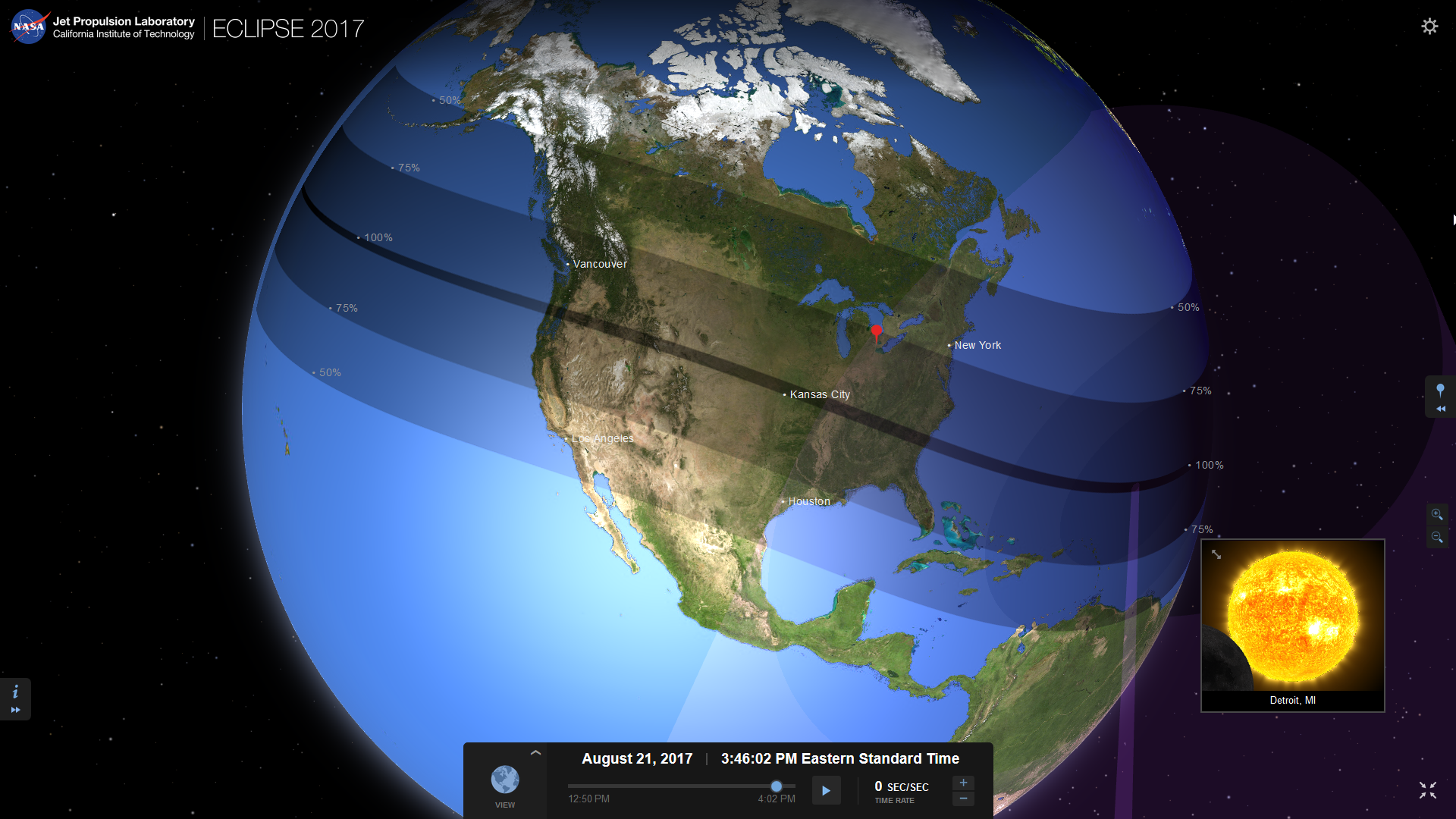You no doubt have heard about the upcoming solar eclipse on Aug. 21, and you probably have questions.
Most importantly, you want to know what we’ll be able to see here in Metro Detroit, and exactly when. This article has everything you need to know, so feel free to forward it to your family and friends, because everybody wants to know!
Recommended Videos
Solar filter needed for telescope
The first thing I want to say is that unlike lunar eclipses (and I’ll explain the difference below), you cannot look at a solar eclipse without a very special solar filter on your telescope, or special eclipse viewing glasses. On a typical summer day, can you look directly at the sun? Of course not. The sun is so bright that you will suffer permanent eye damage if you look at it. In fact, even if the sun is 95 percent blocked by the moon, it’s still way too bright to look at with the naked eye. And trust me: Over the years, I have heard the occasional story about somebody who tried looking at a partial solar eclipse without eclipse glasses, and became blind for the rest of their life. So PLEASE remember this.
How a solar eclipse happens
Alright, let’s talk about how a solar eclipse happens. As you know, the moon orbits the Earth, and the Earth-moon system orbits the sun. Sometimes, the moon is between the Earth and the Sun, but remember: The moon’s orbit is tilted so, usually, the moon isn’t directly between the Earth and the Sun. Only on very special occasions does the sun, the moon and the Earth align directly.
Something else to remember is that the moon’s orbit around the Earth isn’t a perfect circle -- it’s a bit of an ellipse. So, sometimes it’s a little farther away from us, and sometimes it’s a little closer (that’s what causes higher or lower than normal tides on our coastlines). The most remarkable thing about the moon is that its size and distance from the earth are such that it’s approximately the same size as the Sun in our sky! When the moon passes directly in front of the Sun, we say that it’s “eclipsing” the sun, or covering it. When the moon is a little farther away in its orbit, it’s a little bit smaller, and isn’t big enough to completely cover the sun. That’s called an annual solar eclipse, because an annulus (or ring) is seen around the edges of the moon (and by the way, this ring is still way too bright to look at without eye protection).
Here’s a great photo from NASA of an annular eclipse:
It’s much more special when the moon is closer in its orbit. When the closer moon passes directly in front of the Sun, it’s called a total solar eclipse because it completely covers the solar disk. In this instance, as the moon passes between the Earth and the Sun, it casts a shadow that moves across the Earth. Near the center of that shadow, people all of a sudden see twilight develop -- birds suddenly get confused and stop flying because they think it’s night, the temperature drops. And then, it becomes dark (not middle of the night dark, but quite dark).
At this moment, it IS okay to look at the Sun without any special filters or glasses, because the moon is blocking it. The only thing you see is the Sun's corona (or atmosphere) around the edges.
Here’s a great shot from NASA of a total solar eclipse:
Here is a series of visualizations from NASA showing the moon orbiting the Earth during the month leading up to the Aug. 21 eclipse. In these images, the Sun is off the screen to the left, and the purple “beam” is the moon’s shadow. Notice the date at the bottom: I’ve spaced these out one week apart, and you can see in the last image how everything is perfectly aligned so that the moon’s shadow hits the earth.
This next series of NASA images shows the view from “behind” the moon looking at Earth as it crosses directly between the sun and the earth. The little inset in the lower right shows what we will see here in Detroit at that exact corresponding time you see at the bottom of the image. And by the way, if you flip the earth and moon, so that the earth is passing between the moon and the sun, then we see the earth’s shadow go across the moon … that’s called a Lunar Eclipse (which ARE safe to look at)!
And finally, here’s the eclipse’s path across the United States from start to finish. As you can see, the eclipse starts in Oregon and splits the nation in half diagonally before moving off the South Carolina coast into the Atlantic. The darker shaded strip in the middle of the country is the path of totality -- these are the areas that will see the total solar eclipse.
The images above are snapshots from an awesome NASA website, which you can see here. It’s a really cool, interactive site, and you can select anywhere in the nation to see how much of the eclipse they’ll experience there.
Won't go dark in SE Michigan
Here in southeast Michigan, if you didn’t know a thing about the eclipse, you probably wouldn’t know that anything was going on during the afternoon of Aug. 21 because we are not in the path of totality; it won’t get dark here.
However, most of you will know about it, and you’ll want to see something -- IF Mother Nature cooperates, that is. After all, to see the eclipse we need clear or mostly clear skies -- certainly no worse than partly cloudy.
The old standby, which I’ve used in the past, can be simply made using just two pieces of thin cardboard, such as the type that comes with a new shirt you buy. You’ll want to punch a perfectly circular small hole in one piece of the cardboard, smaller than a pencil eraser in diameter. The key is to make sure the hole is circular and clean -- no frayed edges. Then, stand with the sun at your BACK, and hold the cardboard with the hole up so that the sun shines through the hole onto the second piece of cardboard. Adjust the spacing between the two cardboards to focus the image, and you’ll see the sun projected onto the second image! As the moon passes in front of the sun, you’ll begin seeing a little “bite” taken out of the sun, all the way to the point where you’ll see only a crescent of the sun during the point of maximum eclipse. I suppose you can use something thicker, like a piece of plywood, but you’d need to drill those holes, and get them perfectly round.
A LOT of Americans are going to be driving to the path of totality to try and see the eclipse. I’m already hearing about concerns regarding not only traffic congestion on roads headed toward those areas, but also about people not aware of the eclipse driving on freeways in those areas suddenly wondering what’s going on when it starts getting dark and then getting into accidents as they take their attention off the road. And forget about trying to get a hotel room -- most every hotel in the path has been sold out for months, and some for years
When’s the next total solar eclipse opportunity for the U.S.?
A good one will come on April 8, 2024, and that one will take a path from southwest Texas through Cleveland -- the north edge of the path of totality may just make it to Toledo! As you can see, these don’t happen too frequently, which is why this year’s eclipse is getting so much attention. Here are two NASA maps showing the paths of all total solar and annular eclipses from 2000 through the year 2040:
Eclipse stamps
Would you like to get involved with the eclipse in a very different way? Check out these new total solar eclipse Forever stamps issued by the United States Postal Service!
However, what you see is definitely what you get. For the first time ever, a thermochromic ink was used...that means that the ink changes when exposed to heat. So, put your thumb on the stamp, and the eclipsed sun changes into a photo of our moon eclipsing the sun! In my opinion (and I'm a stamp collector), this is the coolest postage ever issued anywhere in the world. These special stamps are available at your local post office, and are a great way to spice up the envelopes you mail. I had the privilege of emceeing the Detroit dedication ceremony of the eclipse stamp, which was held at the Cranbrook Institute of Science. As I told the group in attendance, combining my love for stamps with my love for science made that a pretty special morning for me, and I'm grateful to the Postal Service for the honor of being a part of that special event.
